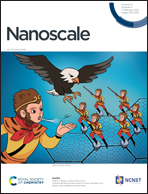Computational screening of pristine and functionalized ordered TiVC MXenes as highly efficient anode materials for lithium-ion batteries†
Abstract
With the rapid development of rechargeable lithium-ion batteries, the search for highly efficient electrode materials has become an ever-growing need for high power density and fast charge–discharge rate to meet the future challenges of energy storage. Two-dimensional MXenes exhibit good electrical and electrochemical properties and are very attractive candidates for anode materials. In this article, we addressed ordered double-metal pristine TiVC and functionalized TiVCT2 (T = O, S, F, or OH) MXenes and investigated their electrochemical properties by using density functional theory calculations. Our results reveal that these ordered MXenes all exhibit metallic characteristics with high electronic conductivity. The diffusion barrier of a Li ion is only 15 meV on the Ti surface and 14 meV on the V surface of the pristine TiVC monolayer. However, functional group terminations markedly increase the Li ion diffusion barrier on TiVC monolayers. Among all the group functionalized TiVCT2 monolayers, the TiVCS2 monolayer exhibits the lowest diffusion barrier of a Li ion (0.191 eV on the Ti surface and 0.186 eV on the V surface). Furthermore, the open circuit voltages of Li ions on both TiVC and TiVCS2 monolayers fall in the range of 0–1.0 V, which may prevent the dendrite formation of alkali metals in the charge/discharge process. Therefore, ordered pristine TiVC and functionalized TiVCS2 monolayers should be promising candidates as anode materials for lithium-ion batteries.



 Please wait while we load your content...
Please wait while we load your content...